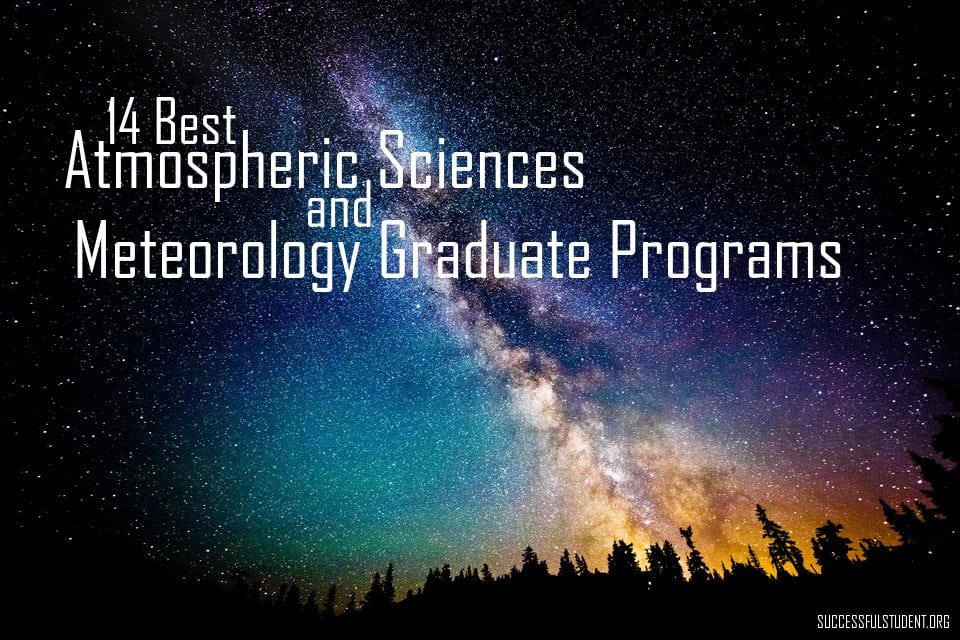| Rank | School | Location |
|---|---|---|
| 1 | Princeton University | Princeton, New Jersey |
| 2 | Cornell University | Ithaca, New York |
| 3 | Massachusetts Institute of Technology | Cambridge, Massachusetts |
| 4 | University of California-Los Angeles | Los Angeles, California |
| 5 | Texas A & M University-College Station | College Station, Texas |
| 6 | Pennsylvania State University-Main Campus | University Park, Pennsylvania |
| 7 | University of Wisconsin-Madison | Madison, Wisconsin |
| 8 | University of Oklahoma | Norman, Oklahoma |
| 9 | Rutgers University-New Brunswick | New Brunswick, New Jersey |
| 10 | Florida State University | Tallahassee, Florida |
| 11 | University of Washington-Seattle Campus | Seattle, Washington |
| 12 | Ohio State University-Main Campus | Columbus, Ohio |
| 13 | University of Illinois Urbana-Champaign | Champaign, Illinois |
| 14 | University of Michigan-Ann Arbor | Ann Arbor, Michigan |
Those studying atmospheric sciences and meteorology use increasingly sophisticated mathematical and computer models to try and map adjusting weather patterns, and then synthesize this data to be useful for everyone, from farmers to daily commuters.
Though a Bachelor's degree may suffice for a position in the field, further education will open many more opportunities. To do professional research, normally a Master's or PhD is required.
The majority can expect to work in a weather station or news agency, however laboratory work and in the field work may also be available. Extended work hours may be required during a weather emergency.
In 2021 the median pay for those with a Bachelor's degree in Atmospheric Scientists, including Meteorologists, was $94,570, according to the Bureau of Labor Statistics. The field is expected to grow at 4% to 2030.

The Best Atmospheric Sciences & Meteorology Graduate Programs
Princeton University
Princeton, New Jersey
In 1964 Princeton University partnered with the Geophysical Fluid Dynamics Laboratory of the National Oceanic and Atmospheric Administration to create the Atmospheric and Oceanic Sciences program.
Part of the Geosciences department, the program has been internationally recognized for its work in the study of global warming and the development of models of atmospheric and oceanic circulation and climate. Graduate students enrolled in the Atmospheric and Oceanic Sciences program should expect to take seven to ten courses during their first two years, with the total length of the program being four years. Class topics may include:
- Boundary Layer Meteorology
- Aerosol Observations and Modeling
- Atmospheric Radiative Transfer
- Weather and Climate Dynamics
Similarly, research topics cover a wide variety of disciplines including:
- Atmospheric physics or chemistry
- Biogeochemistry of the land and ocean
- Paleo-climate
With flexible scheduling options, students will be able to complete their degree in a timely manner and upon graduation feel prepared for either the workforce or further education.
Cornell University
Ithaca, New York
At Cornell University the Graduate Atmospheric Sciences program 'offers full financial support, including tuition, stipend, and health insurance, to all students accepted into our program', thus making admission to the school highly competitive.
Both Master's and Doctoral level studies are available. Students from a variety of science backgrounds are encouraged to apply, including physics, chemistry, and engineering. Admission is not limited to those who have undergraduate credit in specifically atmospheric sciences. Students accepted into the Master's program must earn a minimum of two units of residence credit by completing a semester of full-time study for each unit.
Students accepted into the Doctoral program must complete a minimum of six units of residence credit. All other scheduling is highly flexible and tailored towards each student's educational and professional goals. In addition to the graduate program, Cornell is also known as the only Ivy League university to offer undergraduate studies in Atmospheric Science.
Massachusetts Institute of Technology
Cambridge, Massachusetts
The study of geology at MIT can be traced back to the school's founder and first president William Barton Rogers in 1861. As a professor of natural philosophy and chemistry, he was also the State Geologist of Virginia.
In 1982, the Department of Earth, Atmospheric and Planetary Sciences was founded through the merger of the Department of Earth and Planetary Sciences with the Department of Meteorology and Physical Oceanography.
Today, the Graduate School at MIT offers both Master's and Doctoral studies through the Department of Earth, Atmospheric, and Planetary Sciences, with the primary emphasis on the Doctorate. The program has been recognized as 'second in the country for its number of graduates who obtain tenure-track faculty positions in the earth sciences'.
The Master of Science degree is designed to be completed within two years. However, there is a Fifth-Year Master of Science degree program offered to undergrads.
University of California-Los Angeles
(UCLA)
Los Angeles, California
Both Master's and Doctorates are offered in the study of biology, chemistry, physics, and the atmosphere-ocean system by the Department of Atmospheric and Oceanic Sciences (AOS).
Students enrolled in the Master's program must complete nine courses, or 36 units, before graduation. Six courses of the nine are required entry-level graduate classes, including:
- Introduction to Atmospheric and Ocean Fluid
- Introduction to Dynamics of Earth Systems
- Introduction to Ocean Science
- Introduction to Atmospheric Chemistry
- Introduction to Atmospheric Physics
- Introduction to solar System Plasmas
Those students who studied Atmospheric and Oceanic Sciences at the undergraduate level may be exempt from one or more of the required courses.
Students are allowed up to nine quarters to complete the program. In addition to the graduate studies, UCLA also offers undergraduate studies in Atmospheric, Oceanic, and Environmental Sciences, or an Interdepartmental joint program in Mathematics and AOS.
Texas A & M University-College Station
(Texas A&M)
College Station, Texas
The Department of Atmospheric Sciences at Texas A&M has been recognized as one of the largest, comprehensive graduate and undergraduate research-based meteorology programs in the state and nation.
Located in the College of Geosciences, there are two Master of Science degrees offered: the research based 32-credit hour program, and the non-thesis 36-credit hour program.
The majority of students enrolled in these degree tracks will take two to three years to complete the graduation requirements.
Research topics of the Department include:
- Aerosol
- Atmospheric Dynamics
- Climate
- Remote Sensing
- Radiative Transfer
Upon graduation, students will be prepared for 'careers with both government agencies (such as the National Weather Service) and the private sector'.
Pennsylvania State University-Main Campus
University Park, Pennsylvania
Operating one of the oldest and largest Meteorology departments in the nation, Penn State University offers both Master of Science and Doctorate degrees in the field, with curricula individually tailored to the student's needs and professional goals.
Possible course topics within the Master's program include Dynamic Meteorology, Cloud Physics, Atmospheric Convection, and Bioclimatology. The department of Meteorology and Atmospheric Sciences is located within the College of Earth and Mineral Sciences.
The College maintains a number of research laboratories and facilities, including:
- Air and Precipitation Chemistry Laboratory
- Micrometeorology Laboratory
- Chequamegon Ecosystem-Atmosphere Study Field Sites
- Center for Solutions to Weather and Climate Risk
Additionally, the department manages the largest student-run Campus Weather Service in the country. Penn State also offers undergraduate studies in Meteorology and Atmospheric Science and an online four-course Certificate of Achievement in Weather Forecasting program.
University of Wisconsin-Madison
Madison, Wisconsin
Formally established in 1948, the Department of Atmospheric and Oceanic Sciences at the University of Wisconsin is part of the College of Letters and Sciences.
There are 10 full-time faculty, and two part-time faculty members with specialization in climate systems, satellite and remote sensing, and weather systems (including synoptic-dynamic meteorology).
Students enrolled in the Master of Science program are required to take six core courses:
- Geophysical Fluid Dynamics 1 and 2
- Introduction to Atmospheric Physics
- Radiation in the Atmosphere and Ocean
- Analysis of Atmospheric Systems
- Physical Oceanography
Each course is weighted at three credits. Students take an average of two to three years to complete the M.S. degree. The department maintains academic and research partnerships with various groups including:
- Space Science and Engineering Center
- Cooperative Institute for Meteorological Satellite Studies
- Center for Climate Research
- Center for Sustainability and the Global Environment
University of Oklahoma
Norman, Oklahoma
At the University of Oklahoma, the College of Atmospheric and Geographic Sciences is comprised of the School of Meteorology and the Department of Geography. With approximately 250 undergraduate students and 100 graduate students, the School of Meteorology is one of the largest in North America.
The school is proud to maintain a ranking of 'first in the nation in mesoscale and severe storms research and is among the top seven programs overall'. The Master's of Science in Meteorology program requires 30 to 32 graduate credit hours for the thesis or non-thesis tracks respectively. The majority of students will take two years to complete this degree.
Further educational opportunities include exchange programs which have been established with the University of Reading in the UK, Monash University in Australia, and Hamburg University in Germany. Students may also continue on for the doctoral program. Affiliated research centers and facilities include:
- Atmospheric Radar Research Center
- Center for Analysis and Prediction of Storms
- Center for Spatial Analysis
- Environmental Verification and Analysis Center
Rutgers University-New Brunswick
New Brunswick, New Jersey
Students with undergraduate degrees in any mathematical or scientific field may be candidates for admission to the Rutgers Graduate Program in Atmospheric Science. Both Master of Science and Doctoral programs are available.
The Master of Science program offers a thesis or non-thesis track. The thesis track requires 'a minimum of 24 course credits, 6 research credits, a thesis, and an oral examination on the thesis'.
The non-thesis track requires '30 course credits, an expository essay, and the M.S. Final Examination'. Students attending full-time may complete the program in as little as two years. Those attending part time have up to five years to complete all necessary requirements. Affiliated centers and facilities of research include:
- Rutgers Weather Center
- WeatherWatcher
- Institute of Earth, Ocean, and Atmospheric Sciences
- Rutgers Climate Institute
- Center for Environmental Prediction
As of Spring, 2016 a new Earth Systems Science Certificate is also being offered through the Institute of Earth, Ocean, and Atmospheric Sciences.
Florida State University
Tallahassee, Florida
In the southern portion of the United States, the largest most comprehensive meteorology program can be found at Florida State University. It is also one of the oldest meteorology programs in the nation, having been founded in 1948.
There are 16 dedicated faculty members with years of personal experience to bring to the classroom, with approximately 90 graduate and 200 undergraduate students enrolled. Undergraduate students with a background in meteorology, physics, or mathematics may apply to the graduate school.
Students who are accepted into the graduate program may pursue a Master of Science or a Doctorate in Meteorology. Possible graduate courses include:
- Large-Scale Atmospheric Circulations
- Radar Meteorology
- Midlatitude Synoptic Scale Systems
- Statistical Weather Prediction
- Global Climate System
Affiliated centers for study and research include:
- Center for Ocean-Atmosphere Prediction Studies
- Geophysical Fluid Dynamics Institute
- Tallahassee Office of the National Weather Service
University of Washington-Seattle Campus
Seattle, Washington
In the early 1900s, courses in meteorology were introduced at the University of Washington, and by 1947 the Department of Atmospheric Sciences was formally established. Located in the College of the Environment, the department is a leader in its field, and offers the only undergraduate program in atmospheric sciences in the Pacific Northwest.
In addition to the comprehensive 180 total credit undergraduate program, a Master of Science and a Doctor of Philosophy are also available. The Master's program requires an additional 36 quarter credit hours on top of the bachelor's. Research areas include:
- Arctic/Tropical and Mountain Meteorology
- Biosphere Interactions,
- Clouds and Storms
- Weather Forecasting
Research centers and facilities affiliated with the department include:
- Applied Physics Lab
- Astrobiology Program
- Earth and Space Sciences Department
- Joint Institute for the Study of Atmosphere and Ocean
- Pacific Marine Environmental Lab
- Program on Climate Change
Ohio State University-Main Campus
Columbus, Ohio
Officially established in 1971, the Atmospheric and Climatic Studies program at Ohio State University offers an interdisciplinary graduate track housed in the Department of Geography. Through this degree students will be exposed to a variety of weather-related topics, including:
- Weather and Climate Modeling
- Severe Weather
- Meteorological Instrumentation
- Global Climate Change
- Tropical Climatology and Hurricanes
All students enrolled in the Master of Science degree in Atmospheric Sciences will be required to take courses in atmospheric thermodynamics and radiation. A total of 18 course hours are required for graduation. Other departments and centers affiliated with the program include:
- Byrd Polar and Climate Research Center
- Midwest Regional Climate Center
- National Center for Atmospheric Research/University Corporation for Atmospheric Research
A comprehensive 121 credit hour undergraduate program is also available as a Bachelor of Science in Geography, with a specialization in Atmospheric Science.
University of Illinois Urbana-Champaign
Champaign, Illinois
The College of Liberal Arts and Sciences at the University of Illinois is home to the School of Earth, Society, and the Environment, which is further comprised of the Department of Atmospheric Science.
The department was established in 1969 when the University recruited Professor Yoshimitsu Ogura to establish a Laboratory for Atmospheric Research. With the establishment of the laboratory a quickly thriving graduate program also began.
Today the department is on the forefront of modern atmospheric research with three major areas of focus: Weather and Storms, Aerosols/Clouds/Chemistry and Radiation, and Climate Research. Students enrolled in the Masters of Science in Atmospheric Science are expected to complete 32 credit hours. This applies for both the thesis and non-thesis tracks. Required courses for both options include:
- Dynamic Meteorology
- Physical Meteorology
- Weather Systems
- Climate Dynamics
It is mandatory that students complete the core courses within the first four semesters of enrollment to the program.
University of Michigan-Ann Arbor
Ann Arbor, Michigan
In 1946 the Space Physics Research Laboratory was founded by William G. Dow. This laid the foundations for the Meteorology program at the University of Michigan, which formally began in 1954. Today the Department of Climate and Space Sciences Engineering is located in the College of Engineering.
Both Master's and Doctoral level studies are offered in the field of Climate and Space through the Horace H. Rackham School of Graduate Studies. The Master's degree, however, is terminal. Those wishing for further study should apply directly to the PhD program.
Though a bachelor's degree in any field of study is acceptable for application to the Master's program, certain minimum requirements in math, physics, and chemistry are expected.
The Master of Science program requires 30 credit hours of coursework beyond the bachelor's degree for graduation, 15 of which must be in Climate and Space courses.
More resources:
- The Best Sustainable and Renewable Energy Colleges
- The Best Environmental Science Degree Programs
- The Best Universities Solving Climate Change
- The Best STEM Degrees for Careers of the Future
- The Best Philosophy of Science Degree Programs
- The 10 Best Earth Sciences Undergraduate Programs
- The 10 Best Earth Sciences Undergraduate Programs
Ranking Methodology:
This ranking is designed for students. The purpose of this ranking is to give students an idea of each school's program(s), so that students who wish to pursue Atmospheric Sciences and Meteorology may make an informed choice.
Factors that went into the ranking: academic relevance and variety in their curriculum (breadth and depth), labs and facilities, school reputation, and a track record of students finding employment after graduating. This ranking is for graduate programs (Master's and PhD's).

